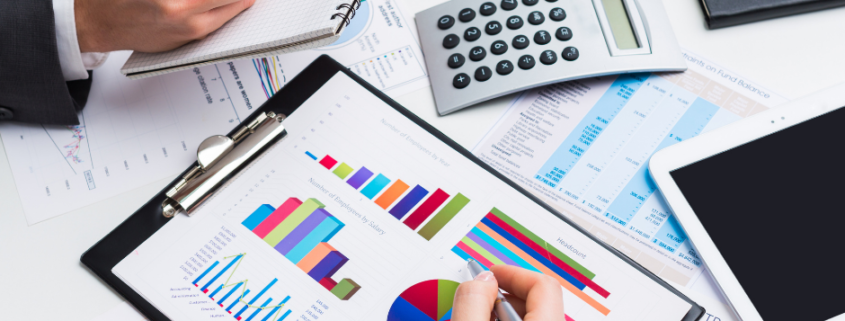Accounting for Restaurants: A Guide to Success for Your Business
- Discover four steps to establishing a smart restaurant bookkeeping process.
- Learn which metrics to keep your eyes on for a successful restaurant business.
- Find out which reports and analyses yield invaluable information about your business.
Operating a restaurant is a dream for many, but there’s a lot more to it than meets the eye. Why do so many restaurants and food-related businesses fail to succeed? Frequently, entrepreneurs spend more time on front of house operations and food preparation than on the business and accounting side. Though it is not the flashy side of the business, accounting and bookkeeping for restaurants is just as important as your menu, décor, and presentation. This is especially true because of the typical narrow profit margins seen in the restaurant business.
To make your success more likely, take the information Fiducial has provided below to heart. Even better, get professional assistance from your Fiducial representative regarding the most important aspects of accounting for restaurants.
Establishing a Smart Restaurant Bookkeeping Process
- Get help
The most important thing to do is hire a bookkeeper if you don’t know what you’re doing when it comes to accounting and bookkeeping for restaurants. Preferably, you should hire one who has specific experience in food and beverage accounting. The more your bookkeeper knows about the specifics of cost of goods sold, front-and-back-of-house operations, and inventory management, the better. - Arm your bookkeeper with the tools that they need
This usually means purchasing a special software package that has been written with accounting for restaurants in mind. The more particular the package, the easier it will make everybody’s life. Look for a program that allows you to make customized invoices, generate profit and loss statements, track your revenue, and review cash flow. It is also important that you can generate customized reports to track trends and that the program is cloud-based. Cloud-based programs allow you to access information on demand. - Categorize your cash flow with a chart of accounts
First, an experienced bookkeeper will set up a chart of accounts that will track assets, expenses, liabilities, revenue, and equity. Then, they will break those categories down into the various specific areas most important for you to keep track of. - Select a Point-of-Sale system that works for your environment
Retail operations have been transformed by state-of-the-art point-of-sale systems that tie every aspect of the business together. A robust program will do far more than generate receipts or place orders with the kitchen. It will also help with inventory management and tie into your sales reporting. System selection should be based on more than bells, whistles, and capabilities. You also want to make sure that your entire team finds it intuitive and easy to work with.

Keeping Your Eyes on The Right Information
Food businesses have many different metrics that need to be tracked. These metrics will give you a clear picture of what is happening, where things are working well, and what needs to be improved. The most important aspects of your business that you need to track include:
- Inventory – Having an inventory management system will help you understand what is selling and what isn’t. It will also help you calculate the right pricing for items that are selling well. By tracking ingredients and supplies, you can take advantage of discounts, order using economies of scale, and avoid waste.
- Sales – Revenue is one of the most important aspects of running any business. When it comes to restaurants it is essential that you know how much you are bringing in from different areas of your business, whether that is liquor and beverage sales as compared to food, dinner as compared to lunch and breakfast, or from catering as compared to in-house dining.
- Cash Management – Tracking cash coming in as compared to going out is the key to keeping your business afloat. It needs to be done every day, then repeated on a weekly and monthly basis. If you do this, you will understand your trending sales and how to schedule your bill payments.
- Accounts Payable – You may struggle to pay vendors, especially at the beginning. However, doing so on a timely basis will ensure that you continue to get the high-quality supplies that you need when you need them. Your accounting software for restaurants offers the best way to keep track of your liabilities. This will help you schedule payments in a way that meets your obligations while also maximizing your cash flow.
- Payroll – One of the most important aspects of any restaurant’s success is the quality of their employees, both in the front and back of the house. However, the challenge lies in keeping track of payroll. Different staff members get paid on different wage structures, and complicated tax processes are involved as well. With an estimated ten percent of the American workforce made up of restaurant employees, plenty of tools exist to ensure that those 14.7 million working in the industry get paid the way that they should and that you track them, whether you have part-time, full time, hourly, or salaried employees.
- Reconciliation – The process of reconciliation ensures that you have everything in your business operations and financial management properly accounted for. This includes your credit card bills, loans, bank accounts, and payroll.
Accounting for Restaurants: Reporting and Analysis
If you are new to the restaurant business, you’ll need to make specific calculations based upon the various reports and financial statements generated by your bookkeeper or accountant. Careful analysis of these calculations will provide you with invaluable information from which you can make decisions. They include:
- Cost of Goods Sold – This metric tells you what it costs you to make the food that you sell. You can calculate it by adding your initial inventory to your purchased inventory and then subtracting your existing inventory. As you can see, in the restaurant business costs are entirely based on the supplies and ingredients needed for the items that you sell to your customers. This means that taking inventory is one of the most important tasks you will perform. You must do it regularly and accurately.
- Prime Costs – This metric accounts for both your cost of goods sold and what you pay to operate your restaurant in terms of labor. Labor costs include wait staff, bar staff, administrative staff, and kitchen staff. The figure you use for labor costs should reflect wages, payroll taxes, and benefits, as well as other employee-related expenses. Though each business is different, the rule of thumb for restaurants is that total labor costs should represent less than one-third of your total revenue. If it is more, you may want to evaluate how much you spend in each labor area and assess the real value.
- Food Costs – This differs from cost of goods sold, as it is reflected as a ratio that divides that number by what you are able to sell the prepared menu item for. To determine your total food costs, divide your cost of goods sold by your total revenue and then multiply by 100.
- Overhead – These expenses include the rent, electricity, and other expenses or fixed costs of running your business. You can add them up and break them down as narrowly or as broadly as you’d like, as some costs are billed monthly and others are daily. Knowing what you are on the line to pay regardless of how business is doing is essential.
- Gross Profit – When you have calculated all of your expenses and all of your sales, you can determine your gross profit by subtracting expenses from total sales.
Tracking the nitty-gritty of expenses and income doesn’t add up to the most fun part of owning a restaurant. However, not doing so means asking for financial trouble in the future. If you prefer to have somebody else take care of this aspect of your business, it will allow you to focus on the part of the industry that you love: the food, the service, and the customers. Want information on how Fiducial can help you with this? Call Fiducial at 1-866-FIDUCIAL or make an appointment at one of our office locations to discuss your situation.
Ready to book an appointment now? Click here. Know someone who might need our services? We love referrals!
For more small business COVID-19 resources, visit Fiducial’s Coronavirus Update Center to find information on SBA loans, tax updates, the Paycheck Protection Program, paid sick and family leave, and more.









